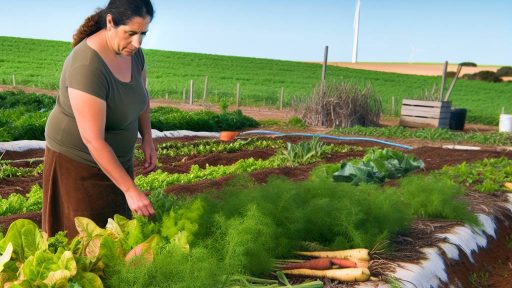Overview of Government Incentives for Renewable Energy in Agriculture
Importance of Renewable Energy in Agriculture
Renewable energy plays a crucial role in modern agriculture.
It reduces dependency on fossil fuels and lowers operational costs.
Furthermore, it contributes to sustainability and combats climate change.
Types of Government Incentives
Government incentives come in various forms to support renewable projects.
Tax credits significantly lower the financial burden for farmers.
Grants provide direct funding for implementing renewable energy systems.
Subsidies help cover initial investment costs for technology upgrades.
Federal Programs and Opportunities
Several federal programs target renewable energy in agriculture.
The USDA offers grants and assistance through the REAP program.
This program supports projects involving solar, wind, and biomass energy.
Additionally, the federal tax credit facilitates investment in renewable resources.
State-Level Initiatives
Various states provide their own incentives for renewable energy adoption.
Some states offer additional tax credits or rebates for farmers.
Moreover, state programs may include grants tailored to local needs.
These initiatives encourage farmers to invest in renewable projects.
Transform Your Agribusiness
Unlock your farm's potential with expert advice tailored to your needs. Get actionable steps that drive real results.
Get StartedEligibility Requirements
Eligibility for government incentives varies based on location and project type.
Applicants often need to demonstrate the project’s potential benefits.
Additionally, they may be required to follow specific technical guidelines.
It’s essential to check both federal and state requirements before applying.
Application Process
The application process for government incentives can be complex.
Farmers should gather all required documentation early on.
Consulting local agricultural extension offices can provide valuable assistance.
Furthermore, many organizations offer workshops to guide applicants.
Types of Incentives Available
Grants
Grants provide direct financial assistance for renewable farming projects.
They do not require repayment, making them highly beneficial.
Farmers can apply for state and federal grants.
Many organizations offer grant programs tailored to specific needs.
Examples include the USDA’s Rural Energy for America Program.
These grants often focus on energy efficiency improvements.
Additionally, some grants may support research and development.
Farmers should explore local and regional grant opportunities.
Tax Credits
Tax credits reduce the amount of tax owed by farmers.
These credits can significantly lower overall project costs.
Federal tax credits encourage the adoption of renewable energy sources.
For instance, the Investment Tax Credit covers solar energy systems.
Farmers should consult tax professionals for optimized benefits.
Each state may offer additional credits to support local initiatives.
Understanding eligibility criteria is crucial for claim success.
Subsidies
Subsidies help offset the costs of implementing renewable projects.
Showcase Your Farming Business
Publish your professional farming services profile on our blog for a one-time fee of $200 and reach a dedicated audience of farmers and agribusiness owners.
Publish Your ProfileThey may come in the form of direct payments or price supports.
Government programs aim to stabilize farmers’ incomes through subsidies.
Renewable energy subsidies can significantly enhance project feasibility.
Farmers should keep track of changing subsidy programs and policies.
Staying informed will allow farmers to capitalize on available funds.
Many organizations assist in navigating subsidy applications.
Additional Considerations
Understanding the landscape of government incentives is essential.
Each type of incentive has specific eligibility requirements.
Farmers should thoroughly research each option available to them.
Networking with others in the industry can provide valuable insights.
Consulting with experts can streamline the process of applying.
Tracking deadlines and submission requirements is crucial.
Farmers should document all applications and correspondence.
Utilizing these incentives can lead to significant savings.
Eligibility Criteria for Farmers Seeking Renewable Project Funding
General Eligibility Requirements
Farmers must operate within designated agricultural zones.
Eligible projects include solar, wind, and biomass energy initiatives.
Farmers must demonstrate the viability of their proposed projects.
Compliance with local, state, and federal regulations is essential.
Financial stability and a proven track record enhance eligibility chances.
Funding Sources and Programs
Various programs offer renewable project funding.
Examples include the USDA’s Rural Energy for America Program.
State-sponsored initiatives may also provide financial support.
Farmers should investigate available grants and low-interest loans.
Researching funding sources is a crucial step in the application process.
Documentation and Application Process
Farmers must gather relevant documentation for funding applications.
This includes project plans, financial statements, and compliance certifications.
Submitting a comprehensive application increases the likelihood of approval.
Be sure to meet all deadlines set by funding agencies.
Seek assistance from agricultural extension offices if needed.
Technical Assessments and Feasibility Studies
A technical assessment is necessary to evaluate project feasibility.
Farmers must work with qualified professionals for accurate assessments.
Feasibility studies should include financial projections and resource availability.
This information is critical in convincing funding bodies of project viability.
Conducting thorough assessments is a vital step in securing funding.
Ongoing Compliance and Reporting Requirements
Recipients of funding must adhere to ongoing compliance requirements.
This includes regular reporting on project progress and financial outcomes.
Farmers must maintain accurate records of expenditures and project results.
Failure to comply with requirements may result in funding loss.
Establishing a solid reporting system can simplify this process.
You Might Also Like: Top Strategies for Farmers to Obtain Research and Development Funding
Showcase Your Farming Business
Publish your professional farming services profile on our blog for a one-time fee of $200 and reach a dedicated audience of farmers and agribusiness owners.
Publish Your ProfileSteps to Apply for Government Incentives
Research Available Incentives
Start by exploring the various government incentives available for farm renewable projects.
Visit official government websites for accurate information.
Look for local, state, and federal programs that support renewable energy initiatives.
Also, consider searching for non-profit organizations offering financial assistance.
Assess Eligibility Criteria
Review the eligibility criteria for each incentive program you find.
Ensure that your farm qualifies based on size, type, and renewable project scope.
If needed, consult with a specialist to better understand the requirements.
Gather Necessary Documentation
Prepare the required documents for your application process.
This may include financial records, project plans, and proof of ownership.
Be thorough to avoid delays in your application approval.
Fill Out Application Forms
Complete the application forms accurately and fully.
Double-check all entries to ensure correctness and completeness.
In some cases, online submission might be available for convenience.
Submit Application
Submit your completed application and all supporting documents before the deadline.
Keep copies of everything you send for your records.
Follow any specific submission guidelines laid out by the program.
Follow Up on Your Application
After submission, monitor the status of your application regularly.
Contact the relevant agency if you haven’t received an acknowledgment in due time.
Be prepared to provide additional information if requested.
Receive and Review Award Notifications
Once notified of an award, review all terms and conditions carefully.
Ask questions if anything seems unclear or ambiguous.
This step ensures that you fully understand your responsibilities moving forward.
Implement Your Project
Once approved, proceed with implementing your renewable project.
Keep meticulous records of expenses and progress throughout the project.
This information may be required for future reporting or audits.
Delve into the Subject: Types Of Conservation Programs Available To Farmers
Funding Opportunities Specific to Solar, Wind, and Biomass Projects
Solar Energy Projects
Solar energy projects benefit significantly from government incentives.
These incentives can help reduce initial investment costs dramatically.
Common funding options include tax credits and grants.
The Solar Investment Tax Credit offers a substantial tax reduction.
Moreover, state-level programs often provide additional incentives.
For example, the California Solar Initiative assists residential installations.
Another option is net metering, allowing farmers to earn credits for excess power generation.
Wind Energy Projects
Wind energy is rapidly gaining traction among renewable energy sources.
Farmers can access federal loans and grants to support wind energy installations.
The Rural Energy for America Program provides funding to implement renewable energy projects.
Furthermore, the Production Tax Credit rewards energy production from wind projects.
States also offer custom programs tailored to local resources and needs.
Understanding these programs is crucial for maximizing funding opportunities.
Biomass Energy Projects
Biomass energy projects harness organic materials effectively.
Showcase Your Farming Business
Publish your professional farming services profile on our blog for a one-time fee of $200 and reach a dedicated audience of farmers and agribusiness owners.
Publish Your ProfileGovernment incentives play an essential role in their development.
The Biomass Crop Assistance Program assists with the production of biomass feedstock.
Additionally, various grants support research and development for these projects.
Federal agencies like the USDA provide funding for biomass power generation.
Farmers should explore both direct funding and technical assistance options.
By leveraging these incentives, they can enhance their project viability.
Navigating the Incentive Landscape
Navigating government incentives requires careful research and planning.
Farmers should stay updated with the latest programs and changes.
Engaging with local agricultural extension services can provide valuable insights.
Moreover, collaborating with renewable energy consultants can lead to successful applications.
Ultimately, understanding the diverse funding opportunities is key to project success.
You Might Also Like: Benefits of Climate-Friendly Regulations for Farmers

How to Navigate Regulatory Compliance for Renewable Projects
Understanding Regulatory Frameworks
Understanding the regulatory frameworks is crucial for success in renewable projects.
Each project must align with federal, state, and local regulations.
Familiarize yourself with the specific requirements in your area.
Building relationships with local authorities can provide valuable insights.
Also, consider reaching out to industry associations for guidance.
Identifying Key Regulations
Identify key regulations that impact renewable energy projects.
Common regulations include environmental impact assessments and zoning laws.
Pay attention to legislation related to land use and permits.
Additionally, understand the compliance requirements for safety and health regulations.
Researching past projects can reveal valuable lessons.
Engaging with Stakeholders
Engaging with stakeholders is a critical step in compliance navigation.
Connect with community members to address concerns openly.
Involve local businesses and groups who may be affected by your project.
Hosting informational sessions can help ease tensions and foster cooperation.
Moreover, stakeholder feedback can improve project design.
Developing a Compliance Checklist
Developing a compliance checklist will streamline the process.
Begin by listing all essential permits and approvals needed.
Include timelines for each requirement to keep the project on track.
Review the checklist regularly and update it as needed.
Accountability is vital; assign responsibility for each item.
Staying Informed on Regulatory Changes
Staying informed about regulatory changes can prove beneficial.
Regulations can evolve rapidly, affecting your project’s compliance status.
Subscribe to newsletters from relevant agencies and organizations.
Attend workshops and conferences that focus on regulatory updates.
Engaging with legal advisors is another excellent approach.
Utilizing Professional Help
Utilizing professional help can simplify navigating complex regulations.
Consider hiring environmental consultants for their expertise.
Legal experts can assist with navigating permitting processes.
Showcase Your Farming Business
Publish your professional farming services profile on our blog for a one-time fee of $200 and reach a dedicated audience of farmers and agribusiness owners.
Publish Your ProfileProject managers experienced in renewable energy can ensure compliance is maintained.
Investing in these resources often pays off in the long run.
Learn More: Renewable Energy Programs Every Farmer Should Know
Case Studies: Successful Farm Projects Utilizing Government Incentives
Solar Energy Implementation at Green Fields Farm
Green Fields Farm in California successfully integrated solar panels into their operations.
The farm received a significant grant from the USDA’s Rural Energy for America Program.
Furthermore, they took advantage of state tax credits, lowering installation costs.
As a result, they reduced their energy expenses by nearly 30% within the first year.
This financial relief allowed them to reinvest in sustainable practices.
Wind Power at Fresh Air Acres
Fresh Air Acres in Texas converted to wind energy with federal incentives.
The farm secured a loan guarantee through the Department of Agriculture.
By collaborating with local energy providers, they developed a wind farm on their land.
This project resulted in substantial energy savings and consistent cash flow.
Moreover, it positioned Fresh Air Acres as a community leader in renewable energy.
Bioenergy Production at Prairie View Ranch
Prairie View Ranch took advantage of government incentives to produce bioenergy.
The ranch received funding for anaerobic digestion technology through state programs.
This technology converts animal waste into renewable energy, reducing operating costs.
Additionally, the project contributes to local carbon reduction goals.
Consequently, Prairie View Ranch improved both their financial and environmental standing.
Community Impact and Future Growth
These farms exemplify how government incentives can foster sustainable agriculture.
They not only benefited individually but also positively impacted their communities.
Local job creation and resource conservation are critical outcomes of these projects.
Future incentives will likely inspire more farmers to pursue renewable energy solutions.
As awareness grows, additional opportunities for funding and collaboration will emerge.
Tips for Effective Project Planning and Documentation for Incentive Applications
Understand Eligibility Criteria
Before starting any project, research the eligibility criteria carefully.
This step helps to ensure that the project aligns with government requirements.
Incentives vary significantly based on the type of renewable project.
Moreover, factors like location and scale can impact eligibility.
Create a Detailed Project Plan
A well-structured project plan serves as the backbone for your application.
Include all relevant phases from initial project design to implementation.
Clearly outline the timeline and key milestones for your project.
Furthermore, identify the resources needed and potential challenges.
Document Everything Thoroughly
Maintain meticulous records throughout the project lifecycle.
This documentation supports your application and serves as proof of compliance.
Include detailed notes on planning discussions, site assessments, and material purchases.
In addition, retain all correspondence related to the project.
Engage with Local Authorities
Establish a relationship with local government offices early in the process.
They can provide valuable insights and clarification on available incentives.
Moreover, local authorities can guide you through permitting processes.
Regularly communicate with them to keep abreast of any changes in regulations.
Provide Clear Financial Projections
Financial transparency is crucial for securing government incentives.
Showcase Your Farming Business
Publish your professional farming services profile on our blog for a one-time fee of $200 and reach a dedicated audience of farmers and agribusiness owners.
Publish Your ProfileCreate detailed budgets and cash flow projections for your project.
Ensure that your financial plans align with the goals of the incentives.
Additionally, specify any funding sources and their intended use.
Highlight Environmental Benefits
Clearly emphasize the environmental advantages of your project in the application.
Potential benefits include reduced carbon emissions and improved energy efficiency.
Quantify these advantages where possible to strengthen your case.
This data adds credibility and urgency to your application.
Review and Edit Your Application
Before submitting, thoroughly review your application for clarity and completeness.
Seek feedback from colleagues with fresh perspectives.
They may identify areas for improvement that you overlooked.
Consider using checklists to ensure no critical information is missing.
Follow Up on Your Application
After submission, follow up with the relevant authorities to confirm receipt.
Inquire about the review timeline and any further information they may need.
This proactive approach demonstrates your commitment to the project.
Finally, stay engaged throughout the approval process for maximized results.
Additional Resources
Ensuring American Leadership in Automated Vehicle Technologies




